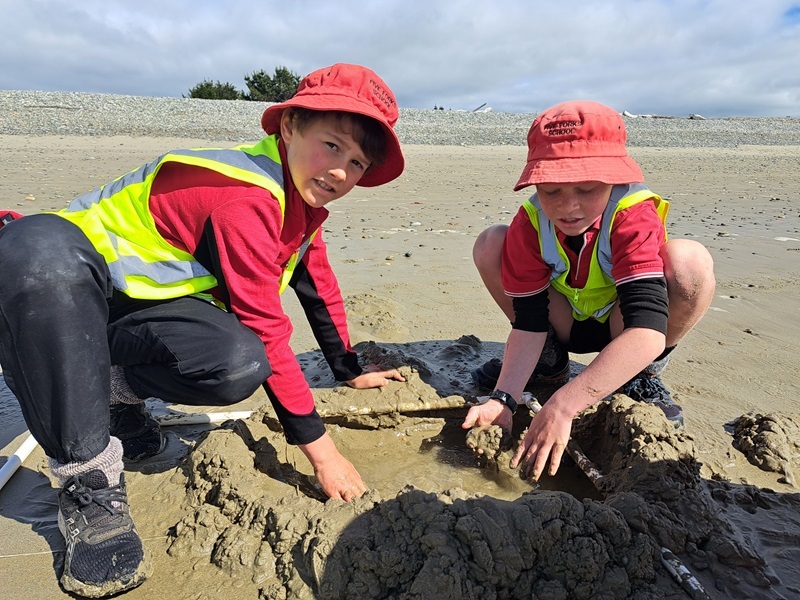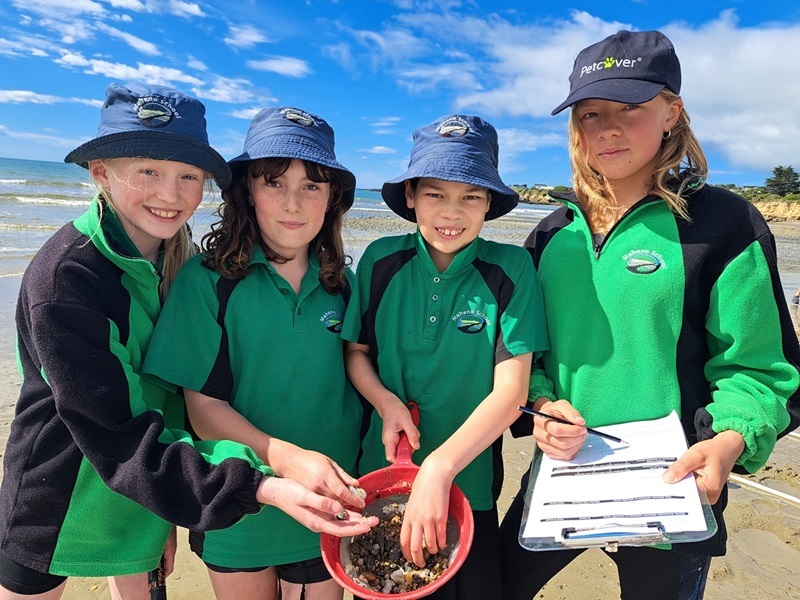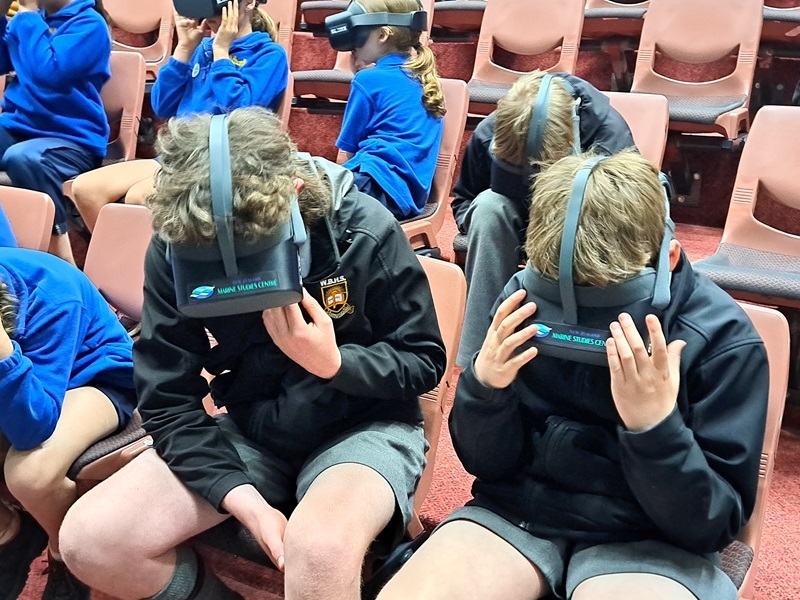Land/sea connections brought home for children
Ashley Smyth
15 November 2023, 11:46 PM
 Totara School pupils (from left) Lucy Harrison (13), Kura Ainsley (12), Chelsea Yumo (12), and Amelie Tartonne (12) carry out a Marine Metre Squared study at Kakanui River mouth on Tuesday. PHOTOS: Ashley Smyth
Totara School pupils (from left) Lucy Harrison (13), Kura Ainsley (12), Chelsea Yumo (12), and Amelie Tartonne (12) carry out a Marine Metre Squared study at Kakanui River mouth on Tuesday. PHOTOS: Ashley Smyth Otago University’s New Zealand Marine Studies Centre has made a splash with North Otago schools this week.
After a successful Aquavan visit to Ōamaru in May, the centre has once again teamed up with North Otago Sustainable Land Management (Noslam) to help educate school children on how keeping their waterways clean affects sea life.
Noslam engagement officer Nic Neal said the centre had brought its virtual reality programme called Threats to the Moana, which is targeted at children year 6 and older.
“It's an interactive virtual reality programme looking at different marine environments and understanding, you know, what pollution might do to them and how water quality improvements can help improve marine life,” she said.
Weston School pupils were treated to the VR sessions on Monday (November 13), Waitaki Boys’ High School year 10s, and some primary Enviroschools pupils on Wednesday, and Papakaio was joined by Ardgowan and Duntroon Schools for their turns on Thursday.
A session was also held for Noslam members at the Fort Enfield Tavern on Wednesday evening.
Meanwhile, on Tuesday, schools from Five Forks, Kakanui, Maheno and Totara came together at the Kakanui River mouth for a citizen-science day, also a collaboration between the Marine Studies Centre and Noslam.

Five Forks School's Owen Ching (11, left) and Byrin Flower (10), dig deep into their 1-metre by 1-metre quadrant.
About 60 children, years 6 to 8, all of whom live on or near the Kakanui catchment area, teamed up to carry out Marine Metre Squared (Mm²) studies.
Groups of four or five children placed 1m x 1m squares on the beach to identify and count all marine life within the quadrant, which is then logged in a national database.
Marine Centre primary and early childhood educator Hannah Drury said Mm² first started in 2013 and is a citizen-science project to encourage communities to get involved in long-term monitoring of the seashore, raising awareness of biodiversity and inspiring conservation.
“It's like, if we know it's there, then we'll care about it a bit more,” she said.
“So we have a website in which you can enter the data, and you can get resources so you're able to do it all yourself anytime you want, without someone from the study centre.
“And then you enter the data that you find onto the website and then that's all correlated from every survey that's ever been done all around the country, and then we can get a really good idea of what's living on our shore.”
The Marine Studies Centre works with catchment groups all over the South Island to help connect communities to their whole waterway - the whole catchment, Hannah said.
“To bring in that interconnectedness of the river, the estuary and the ocean.”
“Working with groups like Noslam, who are working further up the catchment, in the river, with rural communities, we can then bring in our knowledge and expertise and bring that connection to the coast, so then it all kind of comes together nicely.
Nic said it is “amazing” to be able to have scientists from the marine centre come and interact with the children.
“That level of expertise with the kids I think is really wonderful, but it's super amazing that this is their local catchment, you know, this is their place.
“So it's really lovely to make that connection, I think, between the science of what happens upstream and then what happens here at the river mouth and what's living here. It's a really lovely local context.”

Maheno School pupils (from left) Aliyah Robertson (11), Zara McCarthy (11), Sascha Fitzwater (11), and Lina Kurze (12), record what they have found in their square.
Enviroschools Hui
Meanwhile, it was a combination of good luck and good planning that the North Otago Primary Enviroschools Hui was being held at Waitaki Boys’ on Wednesday, when the Marine Centre VR sets were also there.
The hui was supported by Waitaki District and Otago Regional councils, as well as Noslam, and was about exploring the connections between different landscapes from the mountains to the sea, Enviroschools Otago regional coordinator Robyn Zink said.
About 25 pupils, years 4 to 8, from Maheno, Weston and Fenwick schools, spent the day learning about the working compost hub and restorative creek project at the high school, looking into the relationship of the land and sea, and then the coastal marine environment with Dr Phillipa Agnew from the Ōamaru Blue Penguin Colony.
At the end of the day they got to explore New Zealand’s coastal waters with the VR headsets.

Enviroschool pupils from Fenwick, Weston and Maheno Schools enjoy a sea view. PHOTOS: Ashley Smyth
“We've run a range of activities where the students were looking at how catchments work and the sorts of things that we can do to look after our catchments and understanding that the water that goes down the drain goes straight out, in this case, straight out to the harbour,” Robyn said.
“We looked at some of the ways that you can assess water quality at the creek here, and then we also looked at some things around what makes soil healthy because healthy soil absorbs more water and it filters the water going into the creeks.”
This is the first primary school hui in North Otago this year, as well as one for secondary schools and a professional development day for teachers, she said.
The children enjoy mixing with the other schools and other young people with similar interests.
“Hopefully they can go away inspired to see what difference they can make - what else can we be doing at home or at school to make a difference.
“Because this is only a small number from each class, we really encourage them to think about ‘how are you going to share the story of what you've learned here back at school?’.”

Waitaki Boys' High School year 10 pupils immersed in virtual reality.
NEWS
WHAT'S ON GUIDE




